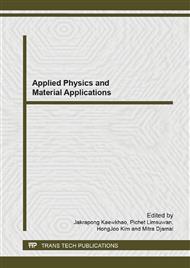p.1
p.10
p.14
p.18
p.22
p.26
p.30
p.34
Effect of Oxygen Partial Pressure on the Morphological Properties and the Photocatalytic Activities of Titania Thin Films on Unheated Substrates by Sputtering Deposition Method
Abstract:
Titania (TiO2) thin films have been deposited using d.c. reactive unbalance magnetron sputtering on unheated substrate by various different oxygen partial pressures while working pressure and sputtering power were kept constant. A pure metallic titanium disk was used for sputtering target in atmospheric of the mixture gases between argon and oxygen. The X-ray diffraction (XRD) and atomic force microscopy (AFM) were used for characterization of characteristics structure and surface morphologies of the films, respectively. The optical transmission of the films were measured by spectrophotometer. The photocatalytic activities of the films were investigated from measurement of methylene blue degradation by using absorbance value after UV irradiation for 6 hr. The results show that the crystalline structures of the films showed the presence of single-anatase phase and mixed-anatase/rutile phase of TiO2 thin films. The surface morphology and photocatalytic activities of the films depend on oxygen partial pressure that grains size, surface roughness and thickness of the films were deceased when increasing oxygen partial pressure due to poisoning phenomenon and the high reactive gases. In addition, it was found that all TiO2 thin films were deposited by different oxygen partial pressure exhibit a good transparentness. Moreover, it was found that the TiO2 thin films deposited by used low oxygen partial pressure and single-anatase phase exhibited the best photocatalytic activity.
Info:
Periodical:
Pages:
18-21
Citation:
Online since:
September 2013
Keywords:
Price:
Сopyright:
© 2013 Trans Tech Publications Ltd. All Rights Reserved
Share:
Citation:


